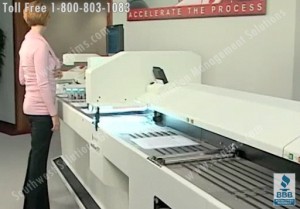Posts Tagged ‘digital imaging’
The First Step of Digital Data Imaging Migration: Problem Identification
Embracing Technology at Home
My Dad was 75 years old when we insisted he learn how to use a computer so we could communicate via email. Today, at 90 years old, he would be lost if he couldn’t send an email or check his accounts from the comfort of his home. My 20-something kids can’t fathom looking at a map or printing out a document, and I’m pretty sure none of them have ever actually seen a fax machine. As for me, I’m taken back when someone asks me to write a check (do they expire if you don’t use them for ten years?). I don’t want a paper receipt that I can lose. I complete applications online and execute contracts at 30,000 feet from my window seat, and most of us would be hard pressed to say we would prefer to go back to filing our taxes on paper forms. We can justify and embrace digital documents from home base, but why do we resist them and digital data imaging in the workplace?
Why are We Still Pushing Paper?
I work with hundreds of organizations that still push mounds of paper through their AP department. Resources are spent opening mail, routing paper, making copies, acquiring signatures, creating checks, and applying postage. You don’t have to be a CFO to know that our old comfortable processes are contrary to our objectives. So where is the logic? One contributing factor is likely job security, especially in today’s uncertain economy. It’s a fear unfounded and typically based in poor communication at a higher level. Getting more efficient doesn’t always mean a reduction in head count; it means we get more value for our dollar. It’s a lean concept that is widely accepted to address “wasted human talent.” Truth be told, most individuals would embrace an opportunity to utilize more of their analytical skills than they would their dexterity capabilities.
Another reason for the hesitancy to embrace digital data imaging may be one that plagues us in every area imaginable: being burnt. Early attempts at digital data imaging migration may not have been a good experience and access to technology without training and a succinct roadmap leaves most of us lost and frustrated. What do we call it? Where do we store it? How do we access it, and who is securing it? There’s added anxiety with the simultaneous introduction of new software applications and of course the ever-present compliance confusion; “Is a digital copy a copy or an original”? If it’s an original can I destroy the paper? As organizations start to delve into the details of digital data imaging migration, paralysis eventually replaces progress, and if organizations are able to get past the initial deterrents of digital data imaging migration, most will eventually stall out at the budget phase, despite the undisputed value on the bottom line.
Digital Data Imaging Migration Solutions Start with Identifying Your Unique Need
So is there a solution? The answer is “no.” There isn’t “a” solution, but there are “many” solutions. Problems arise when organizations try to align themselves with “a solution” before identifying their own unique need. Technology is a tool not a solution. Policy and processes are tools as well. Scanning documents and workflow and cloud storage are all components that may contribute to a solution, but we can be easily lulled into believing that any one of these components is a stand-alone solution.
Once an organization understands the process of “problem identification”, they can start to build a solution that addresses core business objectives rather than slipping into a “one size fits all solution”.
——————————————————————————————————————————————————————————————-
Anna Stratton is Director of Information Management Solutions at Southwest Solutions Group headquartered in Dallas, Texas. Anna specializes in records management and business process protocols, document scanning policy design, and information retention policies and process. Anna has over 18 years of professional business management experience and provides advice nationwide through the SYSTEC Group’s “Ask the Expert” column. Ms. Stratton is also a dynamic national speaker and conducts private corporate seminars on a variety of topics in addition to providing keynote and educational speeches for organizations such as ARMA and the Lorman Seminar Group. Ms. Stratton has been recognized by Cambridge Who’s Who for demonstrating dedication, leadership and excellence in information and asset management.Merging Paper and Electronic Documents | The Digital Data Imaging Migration
I Am a Member of Paper Lovers Anonymous
I’m going to say what none of us want to admit; I like paper! Yes, I use my iPhone and iPad to manage almost every aspect of my life, and I love the ease of electronic transactions and mobility. I want to take part in the progress and the digital data imaging migration, but there are just some areas in my world where paper still works better than electronic documents. I know how to find it (yes, there is a system to those piles), and I know what to do with it. Most of us have just figured out how to use those darn all-in-one copy machines and the thought of learning yet another way is just too daunting to even think about!
The Frustration We Experience Using Electronic Documents
In the same breath, we say we’re OK with change too, (as long as it’s associated with something like winning the lottery). We use electronic documents but don’t always mange them well. We have folder structures that go ten deep that made a lot of sense when we created them but are now the cause of carpel tunnel for all the clicks required to get to a single document. So, we save a document to our desktop where we know we can find it; except now our monitors have become mirrors of chaos that make us long for those paper file folders. In our infinite wisdom, we print those documents so that we can finally get to work on what started the search in the first place and for a single moment we feel a sense of control and inner peace. It’s no wonder digital data imaging is met with such resistance. Before we can really begin thinking about digital data imaging, electronic documents, and document scanning, we need to accept that there is a place for both paper and electronic documents and that the transition cannot be a quantum leap!
A New Perspective on the Paper vs Electronic Documents Conundrum
This is not a “how to” series, but rather a new perspective on how we handle the paper vs electronic document conundrum. The battle will continue between the paper lovers and the digitally determined until we start to recognize what it is we’re all actually battling about. It’s possible that we can continue with forward progress and still allow for a transitional comfort zone. I think both teams get a bad rap. The IT group is under the gun to find new ways for information to be useful while the departments have a confidence issue and are so busy trying to get their work done that they don’t have time to adapt to new ways.
It’s Time for Paper and Electronic Documents to Work Together
I don’t want to get all “rainbows and puppy dogs” here, but at some point we need to figure out how to understand each other. I sit at the table with department managers, IT directors and C-suite executives and no one speaks the same language. The pressure to stay current and relevant is real, but we can’t ignore the core business functions or the people performing them because we risk that the journey to the clouds is going to be a bumpy ride. The good news is that the sun does shine above those clouds (I promise that’s the last sappy statement I’ll make). Trying to figure how to deal with all the paper of the past, the paper we still use, and the paper we don’t want to create anymore includes technology, outsourcing, financial, and change management considerations. Trying to ice out one of those aspects will either paralyze organizations from doing anything or at the minimum, ruffle enough feathers along the way to warrant resistance.
Join me as we navigate through the world of digital data imaging and document scanning and talk about real world scenarios that include problem identification, understanding ROI, and managing changes along the way.
——————————————————————————————————————————————————————————————-
Anna Stratton is Director of Information Management Solutions at Southwest Solutions Group headquartered in Dallas, Texas. Anna specializes in records management and business process protocols, document scanning, policy design, and information retention policies and process. Anna has over 18 years of professional business management experience and provides advice nationwide through the SYSTEC Group’s “Ask the Expert” column. Ms. Stratton is also a dynamic national speaker and conducts private corporate seminars on a variety of topics in addition to providing keynote and educational speeches for organizations such as ARMA and the Lorman Seminar Group. Ms. Stratton has been recognized by Cambridge Who’s Who for demonstrating dedication, leadership and excellence in information and asset management.Document Scanning Services | Converting Records to Digital Imaging
Our Document Scanning Services for Converting Records to Digital Imaging Safely and Efficiently
 We offer document scanning services to speed up the process of converting records to digital imaging. Using state of the art scanning equipment, we are able to provide document scanning services for converting records to digital imaging securely, affordably and quickly. We work with clients that range from small businesses to very large corporations across all industries, to help migrate your scanned documents across the enterprise to ensure the availability, integrity, and longevity of your records and information. Our document scanning services can stand alone, but we also offer records management consulting to help you create a complete program for document and data management. We will help you plan for the unexpected with our disaster recovery planning services to ensure the integrity of your business. Whether its microfilm, paper, microfiche, or a combination, our clients rely on us to manage and digitize their business critical information.
We offer document scanning services to speed up the process of converting records to digital imaging. Using state of the art scanning equipment, we are able to provide document scanning services for converting records to digital imaging securely, affordably and quickly. We work with clients that range from small businesses to very large corporations across all industries, to help migrate your scanned documents across the enterprise to ensure the availability, integrity, and longevity of your records and information. Our document scanning services can stand alone, but we also offer records management consulting to help you create a complete program for document and data management. We will help you plan for the unexpected with our disaster recovery planning services to ensure the integrity of your business. Whether its microfilm, paper, microfiche, or a combination, our clients rely on us to manage and digitize their business critical information.
Is it Time for Your Business to Move From Paper to Digital Imaging?
Are you wondering if it’s time for your business to move from paper to digital imaging? Studies have shown that workers waste 20 to 40 percent of their time searching for paper documents manually. Ironically, we only spend 5 to 15 percent of our time reading the information. Because 90 percent of our corporate information still resides on paper, having the information where you need it, when you need it is often challenging. Also, when the information is no longer current, we spend even more resources retrieve it, box it, store it, and manage retention schedules. (Read more about digital imaging readiness)
To find out more information on our document scanning services for converting records to digital imaging, just give us a call at 1-800-803-1083 or send us an email. We will put you in touch with one of our records management consultants that will provide you with more details and guide you through the digital imaging process.
Digital Imaging Systems for Litigation Support
 Digital imaging technology is increasingly important in litigation support. Law Firms that use digital imaging technology realize immediate performance and productivity gains that improve the management of litigation cases, evidentiary documents, discovery files, due diligence records and boilerplate documents. Southwest Solutions Group is a leading provider of secure high resolution scanning, document coding, Bates stamping and full page OCR scans to assist your law firm.
Digital imaging technology is increasingly important in litigation support. Law Firms that use digital imaging technology realize immediate performance and productivity gains that improve the management of litigation cases, evidentiary documents, discovery files, due diligence records and boilerplate documents. Southwest Solutions Group is a leading provider of secure high resolution scanning, document coding, Bates stamping and full page OCR scans to assist your law firm.
Benefits of Converting to Digital Imaging
There are numerous benefits to converting to digital imaging. First and foremost, no more lost or misfiled documents found in paper-based filing systems. Also, many attorneys have heavy travel schedules, yet they still need access to vital documents. Because our digital filing systems provide secure remote access to information, you can quickly retrieve files when and where they are needed on WIFI connected laptops and handheld devices (Blackberry, iPhone, Androids) safely and securely. Some other cost savings and productivity benefits of converting your  documents to digital imaging are:
documents to digital imaging are:
• Cost savings by reducing the paper file storage requirements will enable your organization to grow, reduce costs, and use floor space for profitable purposes • Cost savings of eliminating off-site storage and document retrieval charges • Increase efficiencies in billable hours and administrative overhead cost savings of making copies and faxing documents • Increase productivity through remote file access using a secure web connection and between offices and departments in different locations (256 Bit SSL Encryption) • Protect your documents from catastrophic loss with a secure disaster recovery plan that provides secure off-site backup and access to information in the event of a disaster • Document workflow, inbound fax receiving, document redaction, editing, and Bates stamping, document consolidation • Integration with your existing Practice Management or Document Management systems • Supplement in house litigation support staff for large cases and remote projects • Unlimited users, document types, and files with no upfront fees • Compatible with most browsers and devices, including iPad, Android, Blackberry, and Mac
Test Our Digital Imaging Services for Free
Our free trial offer includes a full featured document imaging configuration for you to use free for 60 days. There are no restrictions on use within your organization. In addition, we will scan a sample set of files and load them into your viewer to demonstrate the imaging quality of scanned files. We guarantee that our scanned files will be compatible with your practice management and litigation support application.
Why Southwest Solutions Group for Your Digital Imaging System
Southwest Solutions Group is more than a digital imaging conversion company. Southwest Solutions Group has been providing filing products and records management consulting to law firms since 1969. Because we have been helping law firms for years with their paper based filing systems, we understand the flow of critical business documents throughout their lifecycle, from point of creation to final disposition, which offers customers reduced risk and improved operational efficiencies with a verifiable return on investment. We have many qualified information specialists to help you understand the process and protect you from common pitfalls when converting from paper based filing to a document imaging system.
Additional Services by Southwest Solutions Group
We offer many information management services including: • Master planning for converting to document imaging • Document Blowbacks (printing), Bates Stamping. Conversion of digital files (images, worksheets, emails) • Output of load files afro Concordance and other Litigation Support Applications • Backfile scanning of inactive and active records • On-site scanning • High quality production scanning • Packing, purging, and shredding services • Document backup services
Contact us today for more information about our digital imaging free trial at (800) 803-1083 or visit http://www.ssgims.com/legal/
10 Steps to Converting Electronic Medical Records (EMR)
Why Electronic Medical Records (EMR)?
 Healthcare providers all across the U.S. are migrating their medical charts to Electronic Medical Records (EMR) to increase record accuracy, decrease waste, eliminate costly storage space, and improve patient care. Hospitals are also seeking to take advantage of government incentives under the American Recovery and Reinvestment Act (ARRA). Right now, everyone is focusing on the “carrot” of payments they can receive by implementing EMR. But the “stick” comes out in 2015, when hospitals that don’t meet federal guidelines for paperless records may be penalized with reduced Medicare reimbursements.
Healthcare providers all across the U.S. are migrating their medical charts to Electronic Medical Records (EMR) to increase record accuracy, decrease waste, eliminate costly storage space, and improve patient care. Hospitals are also seeking to take advantage of government incentives under the American Recovery and Reinvestment Act (ARRA). Right now, everyone is focusing on the “carrot” of payments they can receive by implementing EMR. But the “stick” comes out in 2015, when hospitals that don’t meet federal guidelines for paperless records may be penalized with reduced Medicare reimbursements.
What’s Holding Healthcare Organizations Back from Using EMR?
 The new government rules to EMR are confusing and picking the right document imaging software system is challenging. Plus, there is significant expense and disruption involved when you make such a big change in how medical records are handled. It’s just not feasible to expect hospitals to do this on their own without expert guidance from information management professionals. Software vendors are happy to sell you imaging hardware and advise you on how to install image software on your computer network; but that doesn’t help with the real-life obstacles you will face in converting your medical file charts to electronic images that can be located when you need them.
The new government rules to EMR are confusing and picking the right document imaging software system is challenging. Plus, there is significant expense and disruption involved when you make such a big change in how medical records are handled. It’s just not feasible to expect hospitals to do this on their own without expert guidance from information management professionals. Software vendors are happy to sell you imaging hardware and advise you on how to install image software on your computer network; but that doesn’t help with the real-life obstacles you will face in converting your medical file charts to electronic images that can be located when you need them.
 Getting Help Converting Electronic Medical Records
Getting Help Converting Electronic Medical Records
Converting medical records to a document imaging system takes the help of a qualified information management specialist who has experience in the EMR imaging process and government requirements. A qualified information management specialist will help you understand the process and avoid common mistakes that can set your organization back. For example, EMR compatible medical records scanning involves more than simply scanning records and uploading a pdf of a patient’s chart into a database. If you don’t have federally approved quality controls in place, you may end up with a bunch of electronic records that are not considered true originals. That’s an excuse Medicare can use to deny payment. Below is an overview of ten steps to converting your medical documents to Electronic Medical Records.
10 Steps to Converting Your Paper Medical Records to EMR
1. Survey – Review your current filing system to discover the best documents to image 2. Plan – Develop a master plan to map and document every step of the conversion process including establishing your document indexing requirements 3. Pack & Manifest – Box and label medical charts/records to be imaged so they can be tracked throughout the conversion process 4. Secure Transportation – Ship record boxes with documents to be scanned and imaged via a bonded courier directly to a secure image conversion facility 5. Validate Receipt – Have the image conversion facility provide receipt of shipment and confirmation documentation of all documents are present 6. Prep & Scanning – The image conversion contractor should prep documents, removing staples and repairing any damaged records before scanning documents with a high quality production scanners to ensure a high quality, clear and complete scan of each file 7. Indexing – Document The image conversion contractor should index documents according to your specifications established in Step Two 8. Quality Control – Request a sampling of imaged documents to ensure scanning and indexing accuracy of each record 9. Output – Upload the scanned records into your EMR software system or supply on CD/DVD if requested 10. Store or Shred – Provide storage, shredding, or secure shipping instructions for paper records



